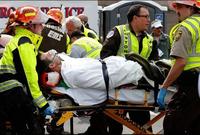-
Using drones in law enforcement work
Using unmanned flight systems for domestic surveillance can provide emergency responders information during fires, earthquakes, storms, and man-made disasters, said John Hill, director of the Indiana Department of Homeland Security.He said that the general public is open to the use of unmanned systems when informed about their use.
-
-
Cloud computing poses technical challenges for digital crime-fighters
The ultimate in distributed computing, cloud computing is revolutionizing how digital data is stored, processed, and transmitted. It enables convenient, on-demand network access to a shared pool of configurable computing resources, including servers, storage, and applications. The characteristics that make this new technology so attractive also create challenges for forensic investigators who must track down evidence in the ever-changing, elastic, on-demand, self-provisioning cloud computing environments.
-
-
California braces for worst wildfire season in memory
California Department of Forestry and Fire Protection(Cal Fire) is bracing for one of the longest and most difficult fire seasons in memory. A recent addition of $23 million to the emergency wildfire budget for the fiscal year that began 1 July, brings the department’s budget total to $209 million. “That’s just the first week, and we still have 51 more weeks to go,” said Daniel Berlant, spokesman for Cal Fire. “We’re not even to the peak of the fire season yet.”
-
-
DARPA seeks to speed new materials development process
Military platforms — such as ships, aircraft, and ground vehicles — rely on advanced materials to make them lighter, stronger, and more resistant to stress, heat, and other harsh environmental conditions. Currently, the process for developing new materials to field in platforms frequently takes more than a decade. DARPA seeks to address this problem by developing a methodology and toolset to compress the applied material development process by at least 75 percent: from an average of ten years or longer to just two and a half years.
-
-
As budget shrinks, DOD needs to rethink strategy to preserve U.S. technological edge
The United States currently accounts for less than one-third of global research and development spending, and this fraction is projected to decline to 18 percent by 2050. Those statistics, together with the recognition that the United States no longer maintains superiority across all research fields, mean that DOD’s technological leadership now depends upon its ability to identify and leverage relevant research advances as they emerge from the global science and technology enterprise, says a new report from the National Research Council.
-
-
Emergency readiness of health-care providers

In 2013 the Centers for Medicare and Medicaid Services(CMS) proposed new preparedness requirements for hospitals and sixteen other types of health care providers, including home health agencies, nursing homes, hospices, transplant centers, and community mental health facilities, to mitigate natural and man-made disasters. Health-care providers say these requirements are too costly.
-
-
IAF begins heavy bombardment of residential areas in north Gaza
As we predicted yesterday, the Israel Air Force (IAF) earlier this morning showered Palestinian urban areas in north Gaza with leaflets giving residents until today (Sunday) at noon (Israel time) to evacuate their homes ahead of massive Israeli bombardment of these area. The leaflets were accompanied by calls to every home phone and cell phone of residents in the area (Israel has all these phone numbers), and radio and TV broadcasts in Arabic. Hamas, in an effort to forestall the Israeli attack by keeping Palestinian civilians as a human shield, has publicly ordered the residents to stay put, branding those who leave as collaborators with the “Zionist enemy.” So far, about a third of the residents have left. Israel has just begun a heavy bombardment on the outskirts of Beit Lahia in order to remind residents that Israel is serious.
-
-
NSA, FBI monitored e-mails of prominent Muslim American leaders, attorneys
The NSA and FBI monitored the e-mails of prominent Muslim American leaders and attorneys, including the head of the largest American Muslim civil rights group, The Intercept reported yesterday. Critics of the surveillance programs of the NSA and other government agencies said the revelations proved their contention that these programs should be more closely monitored. The critics say that in order to obtain FISA court approval for the surveillance, the government alleged that these activists were agents of foreign powers. The critics also note that the monitoring of lawyers’ e-mails raises concerns that some of the information collected may be protected by the attorney-client privilege, which the intelligence agencies are bound to respect.
-
-
Israel launches Operation Solid Rock against Hamas (updated)
The Israeli government has launched Operation Solid Rock, authorizing the calling up 40,000 reservists as it prepares for a long campaign against Hamas, a campaign which may include land incursions into the Gaza Strip. About 10,000 are being called right away, and they will be sent to Israel’s borders in the east and north, allowing army units now stationed there to move south to engage Hamas in the south. The calling up of 10,000 reservists – about four brigades – indicates that, at this stage at least, Israel contemplates a relatively limited ground operation in Gaza. Militants in Gaza have, in the last three days, been launching nearly 100 missiles and rockets a day at Israeli cities and towns in the south of Israel, for a total of 246 missiles and rockets so far. Most of these rockets fell in empty fields. Forty-six missiles (about 27 percent of the total) were heading toward populated areas, and the IDF’s Iron Domes defense system intercepted forty of them, a 97 percent interception success rate. Six missiles managed to go through the defensive system and exploded in populated areas. During the day Tuesday, the night between Tuesday and Wednesday, and earlier this morning, the IDF has intensified its retaliatory strikes against Hamas and Islamic Jihad targets, attacking and destroying more than 450 targets across the Gaza Strip. The Israel Air Force (IAF) says that so far it has dropped more than 400 tons of explosives on targets in the Gaza Strip. The IAF says that the damage it has so far inflicted on the Gaza strip in the first two days of the current operation is greater than the damage inflicted in the eight days of Operation Pillar of Cloud (14-22 November 2012).
-
-
Los Alamos lab admits mishandling toxic waste, causing repository radiation leak
In a letter addressed to the New Mexico Environment Department (NMED), lab officials at Los Alamos National Laboratory (LANL) have admitted to mishandling toxic waste shipped to the Waste Isolation Pilot Plant (WIPP) in Carlsbad, New Mexico, the nation’s only permanent repository for plutonium-contaminated waste from government nuclear facilities.
-
-
Game of marbles inspires nuclear-inspection protocol

Modern cryptography combined with simple radiation detectors could allow nuclear-weapons checks to be carried out with almost complete security. That is the conclusion of scientists in the United States, who have used computer simulations to show how a beam of neutrons can establish the authenticity of a nuclear warhead without revealing any information about that weapon’s composition or design.
-
-
Engineering nuclear nonproliferation

University of Virginia engineering professor Houston Wood’s career demonstrates the important role that engineers can play in making the world a safer place. For more than two decades, Wood has helped governments determine whether nuclear programs in other parts of the world are being dedicated to peaceful or military purposes. In recent years, Wood has been working to determine the break-out time that Iran would require to develop a nuclear weapon if it stopped allowing the International Atomic Energy Agency IAEA) to inspect its nuclear facilities.
-
-
Firefighters mull using drones in fighting wildfires
Federal wildland firefighting officials are exploring the deployment of drones to assist in surveillance and reconnaissance missions during a wildfire. Drones sent to survey fire patterns during a wildfire could help keep firefighters out of risky situations by providing real-time information to officials on the ground. Few wildfire officials have used drones in the line of duty, and managers with the U.S. Bureau of Land Management(BLM) and U.S. Forest Servicesay that while the technology has potential, agencies do not have the budget and have not developed protocols to integrate drones into regular firefighting operations.
-
-
Pentagon should use reduced budget to prepare for "great power conflict": study
As sequestration takes toll on the Pentagon’s budget, Defense officials must decide how to maintain superior military capabilities. A new study suggests that the Pentagon should focus more on a “great power conflict,” reflective of a newly aggressive Russia and rapidly modernizing China. Such an approach would force the department to modernize its current infrastructure and invest significantly in technological advantages at the expense of unlikely-to-be used ships, aircrafts, and soldiers.
-
-
Supreme Court cites NIST guidelines in ruling on cell phone searches
As digital technology transforms twenty-first century life, questions about privacy rights abound. The U.S. Supreme Court ruled on one such question in late June: if you are arrested, can the police search your cell phone without first obtaining a warrant? No, according to the 25 June 2014 ruling in Riley v. California. “Modern cell phones are not just another technological convenience. With all they contain and all they may reveal, they hold for many Americans ‘the privacies of life,’ … The fact that technology now allows an individual to carry such information in his hand does not make the information any less worthy of the protection for which the Founders fought,” Chief Justice John Roberts wrote for the majority.
-